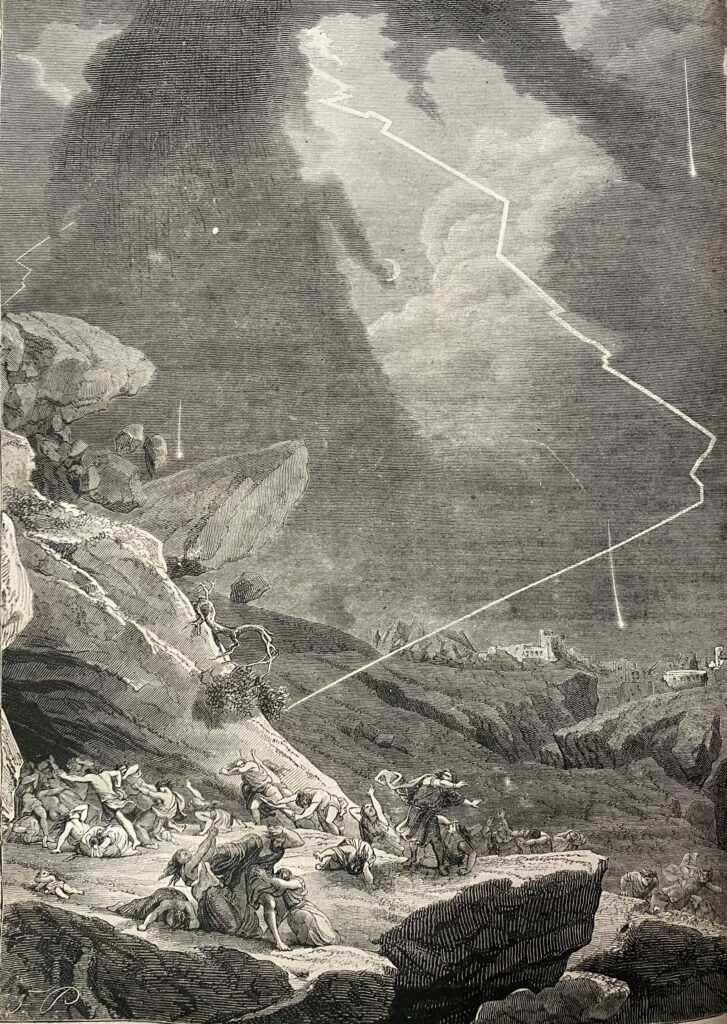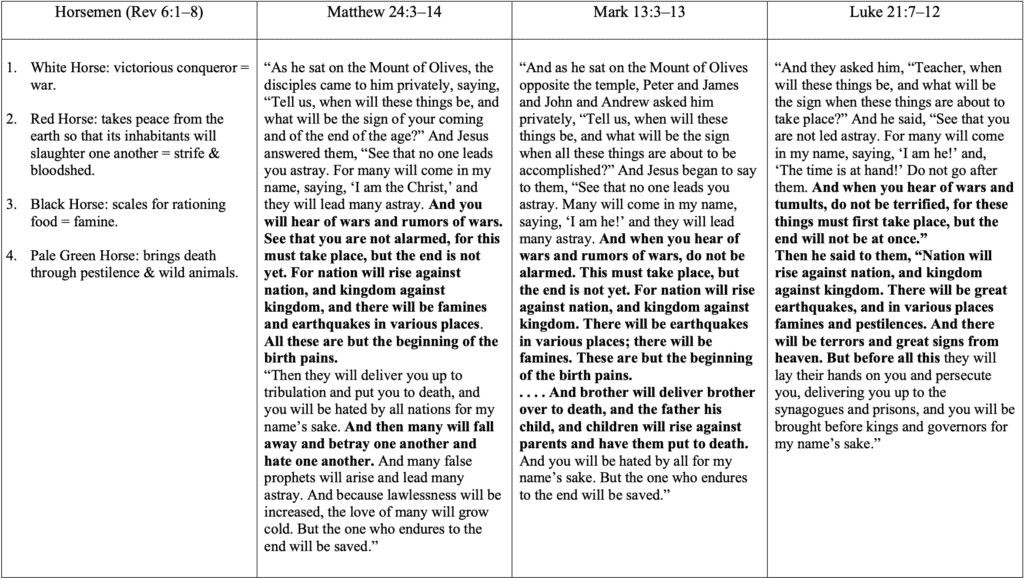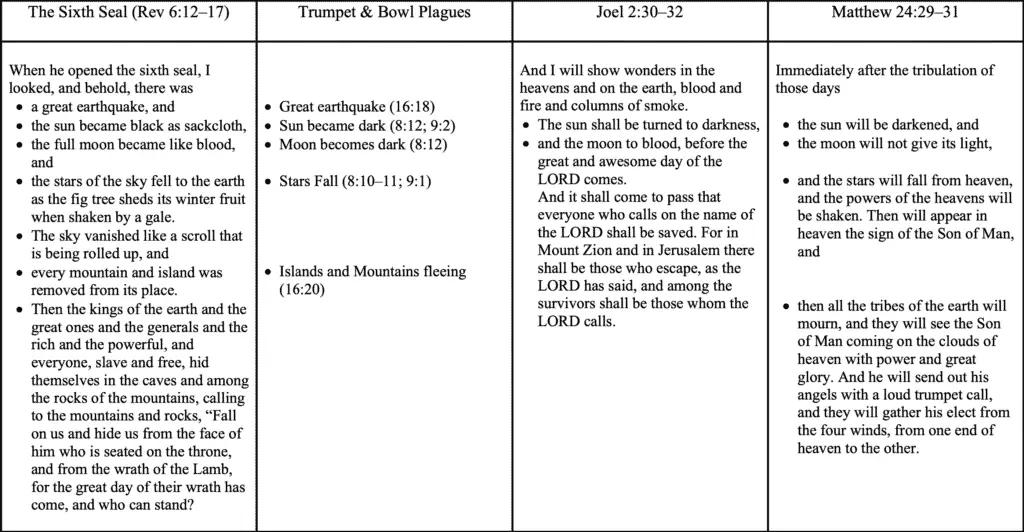
Revelation chapters 1–5 are fairly straight forward and easy to interpret for most readers and easy to preach for most pastors. However, the opening of the scroll’s seven seals in Revelation 6 is where many begin to struggle with the book of Revelation and it is where a close reading becomes extremely important. This article will focus on an interpretation of the seven seals that is consistent with the book of Revelation and with what Jesus says in the Gospels, including when the seals are opened.
The seven seals of Revelation begin Jesus’ wrath against the wicked on the Earth. Seals 1–4 bring judgment upon the wicked now. Seal 5 is a cry for vengeance by Jesus’ people. Seal 6 previews the trumpet and bowl judgments. Seal 7 previews Jesus’ return and connects all judgments to the Lamb.
The first four seals are very similar with each unleashing a different coloured horse (Rev 6:1–8). Whereas, the fifth, sixth, and seventh seals are quite different (Rev 6:9–17; 8:1–5). As such, I will treat the first four seals together, then the subsequent three seals.
I. The First Four Seals: The Four Horsemen of the Apocalypse (Rev 6:1–8)
Revelation 5 is clear that Jesus opens the seals of the scroll after his death, resurrection, and exultation to the right hand of the Father (Rev 5:5–10). This will become important below where I discuss when the seals are opened. For now, I will briefly explain the result of opening each seal from the scroll.
There are two important interpretive keys to notice. First, the colour of the horse and the description of the rider reveal the judgment that the opened seal brings. Second, although it is difficult to see in the English translations, each rider is “given” permission to cause havoc on earth by Jesus. Many English translations, such as the ESV, has translated the sentences in the active voice when the passive is frequently used in the Greek text, indicating that the authority these riders have is given to them by God/Jesus.
A. Interpretation of the First Four Seals (Rev 6:1–8)
The first seal that Jesus opens unleashes a white horse (Rev 6:1–2). The rider has a bow, a crown, and he comes for the purpose of conquering. The identity of the rider has been much discussed and debated, but what is clear is that the rider conquers, suggesting that he brings state-sanctioned wars and oppressive governments to the earth.
The second seal that Jesus opens unleashes a fiery red horse (Rev 6:3–4). The rider of the red horse has a large sword and takes peace from the earth so that the people on the earth would slaughter one another. This seal is different from the first. The first seal suggests military force and government action, whereas the second seal suggests the non-military citizenry of the earth will brutally murder each other (the Greek term translated “slaughter” [σφάζω] can also mean “to butcher”).
The third seal that Jesus opens unleashes a black horse (Rev 6:5–6). The rider of the black horse holds a balance scale in his hand. A voice from heaven is heard by John that helps the reader interpret the third seal: “A quart of wheat for a denarius, and three quarts of barley for a denarius, and do not harm the oil and wine!” (6:6). The rider of the black horse will cause famines and food shortages to come upon the earth.
The fourth seal that Jesus opens unleashes a pale green horse (Rev 6:7–8). The name of the rider is “death.” The name “death” is indicative of what the horse and its rider bring—death. This is confirmed by the text, which says, “and Hades followed him” (6:8). Hades is the place of the dead, confirming that the rider of the pale green horse will cause many on earth to die.
The final sentence of Revelation 6:8 could either be about the fourth rider or a summary statement about all four riders:
“And they were given authority over a fourth of the earth, to kill with sword and with famine and with pestilence and by wild beasts of the earth.”
REVELATION 6:8b, emphasis added
As you can tell, the antecedent to the pronoun “they” is ambiguous. Does the pronoun “they” refer to the fourth rider and Hades or all four riders? To me, it refers to all four riders because there is a reference to each rider. Authority to kill with the sword refers to the riders on the white and red horses (seals #1 & #2). Authority to kill with famine refers to the rider on the black horse (seal #3). Authority to kill with pestilence and by wild beasts refers to the rider on the pale green horse.
B. The Scope and Measure of the Seal Judgments
The scope of the seal judgments (i.e., the death that the riders bring) affects the entire earth. That there are four seals and, thus, four horsemen suggest these riders go throughout the entire earth. The number four in the book of Revelation frequently refers to the totality of the Earth. Further, as will be seen below, Jesus’ words in Matthew 24:3–14, Mark 13:3–13, and Luke 21:7–12 indicate that the death the four horsemen bring will be worldwide.
The seal judgments, however, are measured compared to the trumpet and bowl judgments. Note that the four horsemen “were given [by God] authority over a fourth of the earth” (Rev 6:8). Authority over a fourth of the earth is quite measured compared to the trumpet judgments which affect a third of the earth and the created order (Rev 8:7–12; 9:15–17). It is extremely more measured than the bowl judgments which affect all non-believers and the entire created order (16:1–21). Click HERE to see my article on the trumpet and bowl plagues.
Thus, the seal judgments are the beginning of God’s wrath upon the wicked who are all over the Earth. The seal judgments, however, are much more measured in intensity and scope than the other judgments to come because they only affect about a quarter of the people on earth, as opposed to a third of the wicked with the trumpet judgments and all the wicked with the bowl judgments.
C. The Timing of the First Four Seals
The question that most people want answered is when will Jesus break the first four seals on the scroll and unleash the four horsemen of the apocalypse upon the world? The answer is Jesus opened the seals after his ascension into heaven and the four horsemen have been bringing death upon the earth for the past 2,000 years. Allow me to explain.
The seals are definitely opened after Jesus’ death, resurrection, and ascension into heaven based on Revelation 5:5–10. What is not explicitly clear is how long after Jesus’ ascension he opens the seals. To answer this question clearly, we need to look outside the book of Revelation to what Jesus says in the Gospels.
In three of Jesus’ apocalyptic discourses (Matt 24:3–14; Mark 13:3–13; Luke 21:7–12), he claims that wars (seal #1), slaughter (seal #2), famine (seal #3), and pestilence (seal #4) will happen from the time he ascends until his return. The language used by Jesus in his apocalyptic discourses is the same as that used of the first four seal judgments, leading to the conclusion that the first four seals were opened shortly after Jesus’ ascension to the right hand of the father. The following table illustrates the similarities.

Not only does the death brought by the four horsemen align with what Jesus says will happen between his ascension and return, but we see the effects of the four horsemen in the world today and for the past 2,000 years. All throughout the world there is war, people killing each other, famine, and pestilence (i.e., sickness and disease). Whereas when we look at the trumpet and bowl judgments, we do not see these in the world today.
Finally, it makes theological sense for Jesus to begin his punishment of the wicked at his ascension because he has conquered sin, conquered death, thrown Satan out of heaven (see my article HERE), and has begun to reign over all creation. There is no theological reason for Jesus to postpone his judgment on the wicked to the far and distant future. A major point of Revelation is that God is acting now against the Church’s adversaries, even if it does not look like it.
Thus, it seems reasonable that the first four seals were opened shortly after Jesus’ ascension, releasing the four horsemen who bring the Lamb’s judgment upon the world through wars, murders, famine, pestilence (i.e., sickness and disease), and wild beasts. These more measured judgments upon the world will soon give way to the full wrath of the Lamb in cataclysmic fashion through the trumpet and bowl judgments.
II. The Fifth Seal (Revelation 6:9–11)
The fifth seal is a transitional vision that sees those who have been killed on account of the word of God and their testimony cry out to God for vengeance and judgment against “the earth dwellers” who killed them (6:10, also see Rev 1:9). Since the martyrs are under the altar, John is hearing one of the prayers of the saints inside the golden bowl that is before the altar going up to God (Rev 5:8). The saints are given conquerors clothing and told to wait until the full number of slain has come (Rev 6:11), which foreshadows the heavy persecution of God’s people that is explained in Revelation 12–13.
III. The Sixth Seal (Revelation 6:12–17)
The sixth seal is clearly distinct from the first five seals. When the sixth seal is opened, the following cataclysmic events happen: (1) a great earthquake (Rev 6:12), (2), the sun blackened (6:12), (3) the moon reddened like blood (6:12), (4) the stars falling (6:13), (5) the sky separating (6:14), (6) the mountains and islands moving (6:14), and (7) all earth dwellers (non-believers) fearing God (6:15–17).
Determining when the events of the sixth seal will take place can be difficult to determine, especially since they are so similar to the trumpet and bowl judgments of Revelation. However, it is this similarity that holds the key to sixth seal’s interpretation. The sixth seal not only has allusions to the trumpet and bowl judgments, but with the Day of the Lord in Joel 2:30–32 and Jesus’ eschatological discourse in Matthew 24:29–31. Let’s take a look at each one.
A. The Sixth Seal and the Trumpet and Bowl Judgments of Revelation
As mentioned above the events of the sixth seal are similar to the trumpet and bowl judgments. Note the following:

The trumpet and bowl judgments both happen just prior to Jesus’ return (see my article on the trumpet and bowl judgments HERE). The similarities between the sixth seal, trumpet judgments, and bowl judgments suggest the events of the sixth seal also happen just prior to Jesus’ return.
B. The Sixth Seal and the Day of the Lord in Joel 2:30–32
The events of the sixth seal also have allusions to Joel 2:30–32, which speaks of the Day of the Lord. Note the following:

Joel is clear that cataclysmic events like those detailed in the sixth seal will happen “before the great and awesome day of the LORD comes” (Joel 2:31). The Day of the Lord is the return of Jesus. Thus, the events described in the Joel 2:30–32 are those events that occur just prior to Jesus’ return. The similarities between the sixth seal and Joel 2:30–32 suggest the events of the sixth seal also happen just prior to Jesus’ return.
C. The Sixth Seal and Jesus’ Eschatological Discourse in Matthew 24:29–31
The events of the sixth seal also have allusions to Jesus’ eschatological discourse in Matthew 24:29–31, which speaks of events just prior to Jesus’ return. Note the following:

Without a doubt, Matthew 24:29–31 is clear that the cataclysmic events like those detailed in the sixth seal will happen just prior to Jesus’ return. The similarities between the sixth seal and Matthew 24:29–31 suggest the events of the sixth seal also happen just prior to Jesus’ return.
D. Summary and Explanation of the Sixth Seal of Revelation
The cataclysmic events that happen when the sixth seal is opened are the same events that Joel 2:30–32, Matthew 24:29–31, and Revelation (trumpet and bowl judgments) claim will happen just prior to Jesus’ return. The following table shows the similarities between all four passages.

Based on the table above, it is likely that the sixth seal describes the events that immediately precede the return of Jesus to bring final judgment. Within the book of Revelation, the sixth seal is a summary of trumpets 1–7 and bowls 1–7. As a summary of the trumpet and bowl judgments, the sixth seal reveals that the Lamb’s judgments are not cyclical, but sequential. First, the four horsemen (seals 1–4) roam the earth from the time of Jesus’ ascension to just prior to Jesus’ return when the trumpet plagues begin followed by the bowl plagues, which the sixth seal summarizes for its readers.
IV. The Seventh Seal (Revelation 8:1–5)
The first interlude of Revelation interrupts the opening of the seals (Rev 7:1–17; click HERE for my detailed outline of Revelation). Thus, the seventh seal is not opened until Revelation 8:1–5 with the words “When he [the Lamb] opened the seventh seal.”
Three important things happen when the seventh seal is opened that help the reader understand the seventh seal. First, seven trumpets are given to seven angels:
“Then I saw the seven angels who stand before God, and seven trumpets were given to them.”
REVELATION 8:2
These seven angels begin blowing the trumpets in the next passage, which begin the trumpet judgments (Rev 8:6–9:21). Thus, the seven trumpets are connected to and flow from the seventh seal. John is showing us that the seven trumpet judgments are connected to Jesus’ opening of the scroll. Further, the seventh trumpet leads into the seven bowls (15:1–8), showing that all the judgments began with the Lamb and his breaking of the first seal in Revelation 6:1.
Second, the seventh seal concludes with the second coming of Jesus, evidenced by the thunder, rumblings, lightning, and earthquake (Rev 8:5), all of which indicate that God is coming and manifesting himself (see Rev 4:5). The thunder, rumblings, lightning, and earthquake are also present with the seventh trumpet and seventh bowl, with the seventh trumpet expanding upon the seventh seal and the seventh bowl expanding upon the seventh trumpet. (11:19; 16:18–21). Thus, “John presents a progressive unveiling of the final, climactic judgment through the seventh seal, seventh trumpet, and seventh bowl” (Paul Hoskins, Revelation, 156).
Third, the seventh seal connects the prayers of the saints for vengeance (first seen in the fifth seal) to the subsequent judgments and the return of Christ:
“And another angel came and stood at the altar with a golden censer, and he was given much incense to offer with the prayers of all the saints on the golden altar before the throne, and the smoke of the incense, with the prayers of the saints, rose before God from the hand of the angel.”
REVELATION 8:3–4, emphasis added; also see Rev 6:10
The seventh seal of Revelation thus demonstrates that all 21 judgments (seals, trumpets, and bowls) come from the Lamb and began when the first seal was broken in 6:1. It also shows that the judgments are sequential: first the seals, then the trumpets, then the bowls, not circular (recapitulation). The seventh seal also previews the first glimpse of the return of Jesus in the book of Revelation, which is recounted in its fulness in Revelation 19:11–21. It should not surprise the reader that the seventh seal, seventh trumpet, and seventh bowl reveal Christ’s coming (which is God’s coming) because seven is the number of God.
V. Summary and Concluding Thoughts
The seven seals of the book of Revelation begin Jesus’ wrath against the wicked on the Earth. The first four seals release four horsemen shortly after Jesus’ ascended into heaven. The four horsemen bring the Lamb’s judgment upon the wicked of the world through wars, murders, famine, pestilence, and wild beasts. The fifth seal is a vision of those who have been killed on account of the word of God and their testimony/witness. These martyrs cry out to God for vengeance and judgment against the wicked who killed them. Jesus answers their prayers in the trumpet and bowl judgments that the sixth seal previews. Finally, the seventh seal gives the readers their first glimpse of the return of Jesus while also demonstrating the seal judgments lead into the trumpet judgments, connecting all the judgments to Jesus, the Lamb.
Many Christians relegate the first four seals to the distant future, just prior to Jesus’ return. However, relegating all the judgments in Revelation to the time just prior to Jesus’ return would mean Jesus (and, thus, God) is not doing anything about the wicked now; he is not judging the wicked now; and he is allowing the wicked to run amok on the Earth now. However, using Jesus’ own words from Matthew, Mark, and Luke we can see that Jesus began judging the wicked 2,000 years ago when he ascended to the right hand of the Father by unleashing the four horsemen upon the Earth. The Lamb’s current wrath against the wicked should comfort God’s people. The Lamb has heard the cries of his people and is acting on their behalf. Jesus will not allow his people to be abused and do nothing in return. All praise to our Lord and King, Jesus.

